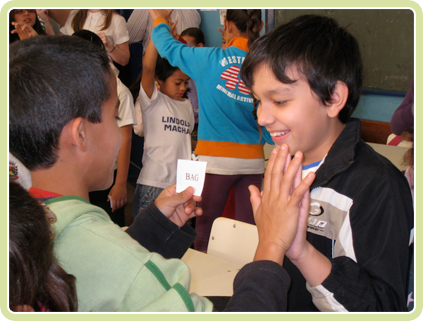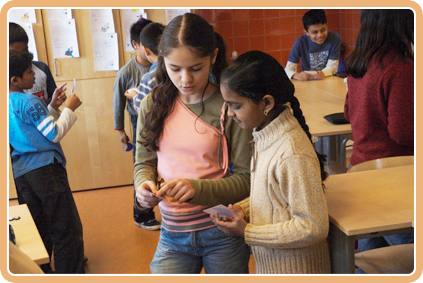Kagan's Articles - FREE Kagan Articles
Articles by Dr. Vern Minor
Kagan Connections—Differentiated Instruction
Special Article
Differentiated Instruction

Dr. Vern Minor
Director of Educational leadership
To cite this article: Minor, V. Differentiated Instruction. San Clemente, CA: Kagan Publishing. Kagan Online Magazine, Spring/Summer 2015. www.KaganOnline.com
Background

“All kids can learn.” What a simple proposition. This mantra has been public education’s battle cry for decades. While the concept may seem straightforward and uncomplicated to the average person on the street, the challenge has been daunting for educators. Education reform efforts of the past have failed to bridge achievement gaps that exist for so many. Nevertheless, the charge remains—we must reach all students. “What matters are conceptions of teaching, learning, assessment... that all students can progress, that achievement for all is changeable (and not fixed), and that progress for all is understood and articulated” (Hattie, 2009, p. 35). Even a cursory review of the Common Core State Standards reveals that there is a strong emphasis on equity and a high expectation for meeting the needs of all learners.
The NGA (National Governors’ Association) and the CCSSO (Council of Chief State School Officers) strongly believe that all students should be held to the same high expectations in the Common Core State Standards. This includes students who are English language learners (ELLS)... Students with disabilities—students eligible under IDEA—must be challenged to excel within the general curriculum and be prepared for success in their post-school lives, including college and/or careers... Promoting a culture of high expectations for all students is a fundamental goal of the Common Core State Standards (Common Core State Standards Initiative, 2014).
In the midst of the emphasis on all, however, has also come an appeal for meeting the needs of the individual. Efforts to reach all have, at times, resulted in an approach to instruction that is sometimes labeled as “teaching to the middle.” Such an approach to instruction has proven to be ineffective—high achieving students are often left unchallenged in such settings, and lower achieving students do not receive the support they need. The result—achievement gaps. One solution to these problems that has been espoused by some in the educational field is an approach to teaching called differentiated instruction. The theory is based on the premise that instructional practices should be varied and adapted to individual learners (Tomlinson, 2001). The goal is to enable students with diverse learning needs to master the same academic standards. “Its (differentiated instruction) primary goal is ensuring that teachers focus on processes and procedures that ensure effective learning for varied individuals” (Tomlinson & McTighe, 2006, p. 3).
On the surface, there are few in the educational field who would disagree with this premise. We should be able to meet the needs of all learners in the general classroom setting; however, putting this notion into practice is seemingly the exception, not the rule. “Research suggests that most teachers believe it is desirable to attend to learner variance as they teach. That is the case across grades and subjects and among teachers of all experiential levels. Research also suggests to us that few teachers in fact translate that ideal into classroom practice” (Tomlinson & McTighe, 2006, p. 39).
It’s not that educators have ignored the needs of diverse learners; they have certainly attempted to differentiate. The problem lies in the approach that has typically been employed. More often than not, efforts to meet individual needs have been attempted through differentiation of the curriculum. While certainly there are times when this is warranted, rampant use of this approach has resulted in the lowering of academic standards for many children. This, in turn, has spawned lowered expectations for numerous students. For decades researchers have known the importance of maintaining a climate of high expectations for success. “Perhaps the most significant difference between the effective and less effective school is found in the staff’s perception of the learning potential of the students” (Lezotte & Jacoby, 1990, p. 148). Lowering expectations inevitably creates a self-fulfilling prophecy (Hattie, 2009), and the result is a widening of the achievement gap.
So what is the answer? The answer can be found not so much in curriculum as in instruction. “Instruction is at the core of differentiation” (Tomlinson & Moon, 2013). Many researchers contend that instruction is far more powerful in enhancing student achievement than curriculum. Dylan Wiliam (2011, p. 13) noted, “A bad curriculum well taught is invariably a better experience for students than a good curriculum badly taught: pedagogy trumps curriculum.” Teachers need sound, instructional strategies that enable them to not only meet the needs of all but also differentiate for the few. In a time when workload intensification is becoming problematic for teachers (Sugden, 2010), instructors need strategies that are simple, proven, and research-based in order to meet the needs of diverse learners.
Such is the case for cooperative learning. This strategy is one of the most well researched educational interventions of our time with extremely positive outcomes. Cooperative learning enables teachers to reach a number of critical objectives simultaneously—increase academic achievement, develop effective social skills, improve race relations, reduce classroom disruptions, enhance communication skills, increase motivation, and close the achievement gap. “Cooperative learning is the single most effective educational innovation to simultaneously address the many challenges and crises we face in our schools and our society” (Kagan, S. & Kagan, M., 2009, p. 3.1).
Cooperative learning is also an effective means by which to differentiate. Teachers want to meet the needs of all children; however, because of the demands associated with the profession, what they need in order to do so are multi-faceted, effectual methodologies. The purpose of this document is to demonstrate how cooperative learning is a useful tool to help a teacher differentiate in the classroom. More specifically, we explore how Kagan Structures are philosophically consistent with the principles that undergird differentiation. Additionally, we demonstrate how simple it is to differentiate using these proven instructional strategies.
Differentiation Tenets
“Values are the link between emotion and behavior, the connection between what we feel and what we do... With everything changing around us we need something unchanging... to hang on to... Values are our moral navigational devices” (Champy, 1995, p. 78). Values, principles, beliefs—whatever term one embraces, the truth remains the same—are a driving force which determine our behaviors. What are the foundational precepts of differentiation? Experts in the field have identified “…beliefs that point to differentiated instruction” (Tomlinson & Imbeau, 2010, p. 27). In this section, we briefly explore some of these tenets in terms of how cooperative learning dovetails with them philosophically.
(Tomlinson & Imbeau, 2010, p. 27)
What is often communicated to students in traditional classroom settings, albeit inadvertently, is that the learning of all is not valued. Consider the method used by traditional teachers during question and answer time in a lesson. The teacher asks a question, a few students’ hands are raised, and the teacher selects two, possibly three, students to respond. Other students, even if hands are raised, are not provided an opportunity to answer. Additionally, it is not uncommon in traditional settings for a select few students to answer most of the teacher’s questions. This technique of checking for understanding (i.e., calling on one student at a time) communicates to students that only some individuals have responses worth hearing.

The message sent to students in cooperative classrooms, however, is far different. Let’s examine how a teacher who employs cooperative learning strategies addresses question and answer time in a lesson. The teacher asks a question, but rather than calling on one student at a time, the teacher asks all children to respond through some type of structured student-to-student interaction. In other words, by utilizing Kagan Structures, a teacher can call on all students to respond to a question in the same amount of time that is reserved for two or three individuals in a traditional setting. By giving every student an opportunity to equally participate in class, children are shown respect and treated with dignity. Teachers in cooperative settings overtly demonstrate to students that all children have answers worth hearing.
At the heart of cooperative learning is a commitment to the education of every student. Kagan Structures are one of the few pedagogical approaches that ensure all students are fully engaged. While other instructional practices encourage engagement, few, if any, ensure high levels of student engagement for all children. A cooperative classroom makes certain every child is active in the room—active with the content being taught and active with one another. Teachers using Kagan Structures communicate to children that all students are valued.
(Tomlinson & Imbeau, 2010, p. 29)
Traditional settings often communicate a message to children that runs counter to democratic principles. Consider again the earlier illustration of soliciting student responses during checking for understanding. Calling on only a select few children to answer questions, especially when the vast majority of the time those being called upon are high achievers, mirrors an elitist society. Traditional instructional practices have created huge achievement gaps between subgroups of students, resulting in a polarized system characterized by haves (i.e., high achievers) and have-nots (i.e., low achievers).
Cooperative classrooms, however, resemble a more democratic setting. It is possible using Kagan Structures to narrow achievement gaps, improve race relations, and develop essential social skills in children. Promoting the importance of equity and equality among students, essential elements in cooperative learning, is compatible with the principles of a democratic society. Democracy is not “…nurtured by a system that fosters racial cleavages, educates only an elite group, models autocratic decision making, and expects passive obedience among pupils” (Kagan, S. & Kagan, M., 2009, p. 2.16). Rather, cooperative learning mirrors the type of society that we desire, one in which “…everyone is on the same side, hoping for and working for the success of others” (Kagan, 2013, p. 46).
(Tomlinson & Imbeau, 2010, p. 27)
A central tenet of cooperative learning is the principle of equal participation. For education outcomes to be equitable, it is critical that participation in the classroom is relatively equal. Kagan Structures go far beyond simply offering equal opportunities for students; Kagan Structures ensure that all students equally participate in class.
In traditional classrooms, students often do not take advantage of opportunities that are provided to them. Some embrace the chance to learn, but others—for a host of reasons—choose to remain passive in the learning environment. When some students engage while others disengage, achievement gaps grow and equity is seriously compromised. Kagan Structures, on the other hand, do not allow this to transpire. All Kagan Structures make sure every child in the classroom receives equal time and/or equal turns. Kagan Structures ensure equity—few pedagogical strategies can make such a claim.
(Tomlinson & Imbeau, 2010, p. 27)
No educator would refute this goal. Unfortunately, teachers have not been provided the tools to enable them to individualize instruction. Instead, as noted earlier, many teach “to the middle” in hopes that all students will in some fashion be reached. The impact of this approach to teaching has created, over time, gaps in achievement levels. Furthermore, students who have excelled in traditional settings often do not reach their full potential.
Kagan Structures, because of the cooperative learning principles that are embedded in them, directly address both of these issues. For one, they systematically support struggling learners, which narrows achievement gaps. Additionally, they consistently stretch higher achieving learners by enabling them to master skill sets that are critical for success in the 21st century (e.g., communications, social, thinking, collaboration). When four critical principles are prevalent in a classroom—Positive Interdependence, Individual Accountability, Equal Participation, and Simultaneous Interaction—individual learners can be successfully encouraged to maximize their abilities. Kagan Structures ensure these four principles are rooted in daily instruction.